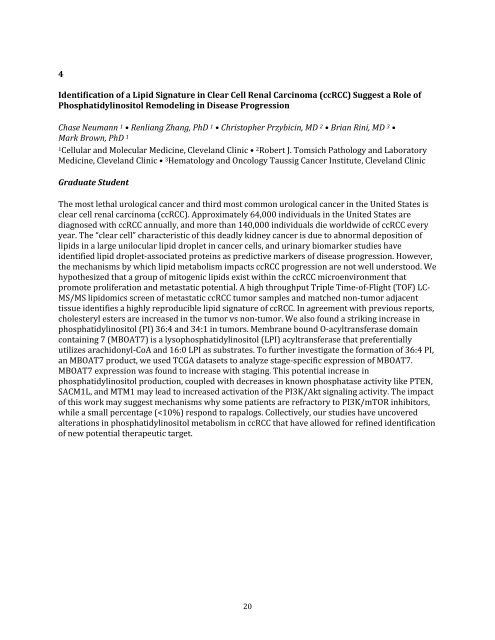2017 Cardiovascular Research Day Abstract Book
You also want an ePaper? Increase the reach of your titles
YUMPU automatically turns print PDFs into web optimized ePapers that Google loves.
4<br />
Identification of a Lipid Signature in Clear Cell Renal Carcinoma (ccRCC) Suggest a Role of<br />
Phosphatidylinositol Remodeling in Disease Progression<br />
Chase Neumann 1 • Renliang Zhang, PhD 1 • Christopher Przybicin, MD 2 • Brian Rini, MD 3 •<br />
Mark Brown, PhD 1<br />
1Cellular and Molecular Medicine, Cleveland Clinic • 2 Robert J. Tomsich Pathology and Laboratory<br />
Medicine, Cleveland Clinic • 3 Hematology and Oncology Taussig Cancer Institute, Cleveland Clinic<br />
Graduate Student<br />
The most lethal urological cancer and third most common urological cancer in the United States is<br />
clear cell renal carcinoma (ccRCC). Approximately 64,000 individuals in the United States are<br />
diagnosed with ccRCC annually, and more than 140,000 individuals die worldwide of ccRCC every<br />
year. The “clear cell” characteristic of this deadly kidney cancer is due to abnormal deposition of<br />
lipids in a large unilocular lipid droplet in cancer cells, and urinary biomarker studies have<br />
identified lipid droplet-associated proteins as predictive markers of disease progression. However,<br />
the mechanisms by which lipid metabolism impacts ccRCC progression are not well understood. We<br />
hypothesized that a group of mitogenic lipids exist within the ccRCC microenvironment that<br />
promote proliferation and metastatic potential. A high throughput Triple Time-of-Flight (TOF) LC-<br />
MS/MS lipidomics screen of metastatic ccRCC tumor samples and matched non-tumor adjacent<br />
tissue identifies a highly reproducible lipid signature of ccRCC. In agreement with previous reports,<br />
cholesteryl esters are increased in the tumor vs non-tumor. We also found a striking increase in<br />
phosphatidylinositol (PI) 36:4 and 34:1 in tumors. Membrane bound O-acyltransferase domain<br />
containing 7 (MBOAT7) is a lysophosphatidylinositol (LPI) acyltransferase that preferentially<br />
utilizes arachidonyl-CoA and 16:0 LPI as substrates. To further investigate the formation of 36:4 PI,<br />
an MBOAT7 product, we used TCGA datasets to analyze stage-specific expression of MBOAT7.<br />
MBOAT7 expression was found to increase with staging. This potential increase in<br />
phosphatidylinositol production, coupled with decreases in known phosphatase activity like PTEN,<br />
SACM1L, and MTM1 may lead to increased activation of the PI3K/Akt signaling activity. The impact<br />
of this work may suggest mechanisms why some patients are refractory to PI3K/mTOR inhibitors,<br />
while a small percentage (


